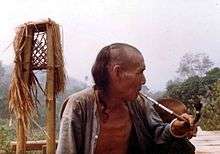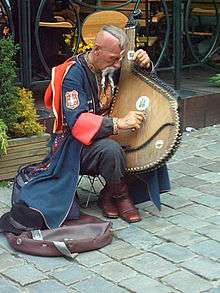Sikha
The sikha or shikha (Sanskrit: शिखा; IAST: śikhā; "crest"; Hindi चोटी (choTi)) means flame, powerful, peak of a mountain. It is a name of Hindu / Indian origin, and is commonly used for females. It also means long tuft, or lock of hair, left on top or on the back of the shaven head of a male Orthodox Hindu. Though traditionally all Hindus were required to wear a śikhā, today it is seen mainly among Brahmins and temple priests.
Procedure
Traditionally, Hindu men shave off all their hair as a child in a sanskāra or ritual known as the chudakarama. A lock of hair is left at the crown (sahasrara).[1] Unlike most other eastern cultures (including ancient Egypt) where a coming-of-age ceremony removed childhood locks of hair similar to the śikhā (e.g. a forelock or pigtails in China, a topknot in Thailand, a sidelock in Egypt etc.) in India this prepubescent hairstyle is left to grow throughout the man's life, though usually only the most orthodox religious men will continue this hairstyle.
The śikhā is tied back or knotted to perform religious rites. Only funerals and death anniversaries are performed with the śikhā untied or with dishevelled hair. Dishevelled hair is considered inauspicious, and represents times of great sorrow or calamity. In Hindu scripture, Draupadi took an oath in the assembly of the Kurus after she was molested by Dushasana that she would remain with dishevelled hair until the enemies were properly revenged. Similarly, Chanakya is said to have taken an oath to leave his śikhā untied until he humbles the Nanda kings who insulted him.
Tamil Nadu and Kerala
The Tamilword for śikhā is kudumi[2] and traditionally it is represented in two styles. The most common kudumi (called Pin Kudumi) is identical to the śikhā, with a knotted lock of hair on the crown of the head and the rest of the hair shaved off.
Mun-Kudumi is a style where the hair is grown long in the front and knotted to the forehead. This hairstyle was popular among some Brahmin groups of South India, such as the Chozhiya, Dikshitar, and Namboothiris of Kerala. The prominent communities in Kerala including the ruling class, Nairs and temple servants (Ambalavasi), though not Brahmins, also sported this style.
The technique used to tie the hair into a Kudumi is as follows: The lengthy hair can be tied with the help of left thumb and index fingers. You roll up the lock of hair over the left thumb and index fingers put together by your right hand till you reach the tail end. Then hold the tail end of hair by the left thumb and index fingers and pull out the fingers with the tail end of the hair. You get the knot. After some little practice you will get a tight and neat knot.
Maharashtra
The Marathi word for śikhā is shendi.
Hinduism
The śikhā reportedly signifies one-pointed (ekanta) focus on a spiritual goal, and devotion to God. It is also an indication of cleanliness, as well as personal sacrifice to God. According to Smriti Shastras, it is mandatory for all Hindus to keep śikhā[3] and the first three twice-born or dvija castes (brahmins, kshatriyas and vaisyas) to wear yajnopavita (sacred thread), also called janeu, punool, or paita.[4] It has been said that the śikhā allows God to pull one to heaven, or at least from this material world of maya (illusion).
In his autobiography, Mohandas K. Gandhi writes about his encounter with an orthodox Hindu:
He was pained to miss the shikha (tuft of hair) on my head and the sacred thread about my neck and said: 'It pains me to see you, a believing Hindu, going without a sacred thread and the shikha. These are the two external symbols of Hinduism and every Hindu ought to wear them.' ... [T]he shikha was considered obligatory by elders. On the eve of my going to England, however, I got rid of the shikha, lest when I was bareheaded it should expose me to ridicule and make me look, as I then thought, a barbarian in the eyes of the Englishmen. In fact this cowardly feeling carried me so far that in South Africa I got my cousin Chhaganlal Gandhi, who was religiously wearing the shikha, to do away with it. I feared that it might come in the way of his public work and so, even at the risk of paining him, I made him get rid of it.WikiSource
The śikhā was one of the few symbols of Hindus that transcended caste, language or regional barriers. Although there were variations of the style of sikha amongst communities, it was obligatory for all males.
Similar hairstyles
Hindus have a common belief that the śikhā "allows God to easily pull one to paradise". While the śikhā has been known to exist in India for from as far back as Chanakya, some scholars have argued that this be an Islamic, or at least an Arabian superstition, as the following passages may illustrate:
Sir Thomas Herbert, 1st Baronet (1606–1682) described a similar hairstyle worn by Persians in his book 'Travels in Persia':
The Persians allow no part of their body hair except the upper lip, which they wear long and thick and turning downwards; as also a lock upon the crown of the head, by which they are made to believe their Prophet will at Resurrection lift them into paradise. Elsewhere their head is shaven or made incapable of hair by the oil dowae (daway) being thrice anointed. This had been made the mode of the Oriental people since the promulgation of the alcoran (Al Quran), introduced and first imposed by the Arabians.— [5]
In 'Passages of Eastern Travel', Harper's magazine, 1856, p. 197, an American traveller wrote:
All Arabs, men and boys, have their heads shaved, leaving only a scalp lock, said by some to be left in imitation of the Prophet, who wore his own thus; and by others said to be for the convenience of the angel who will pull them out of the graves when the day of rising shall come.— [6]
Riffian (Berber) men of Morocco had the custom of shaving the head but leaving a single lock of hair on either the crown, left, or right side of the head, so that the angel Azrael is able "...to pull them up to heaven on the Last Day." [7]
High-born Chamorri men of the indigenous Chamorro people of the Mariana Islands also wore a hairstyle similar to the śikhā.[8] (see statues of Chief Gadao or Chief Quipuha in Chief Quipuha Park, Paseo de Susana peninsula, Agana, Guam.) Later, particularly on the island of Guam, this śikhā-like top-knot hairstyle became somewhat of a political statement for young men:[9]
In the late 1980s, early 1990s there was a resurgence of the top-knot hair style. One of our senators now, before he became a 'certified' politician, was sort of a radical activist. He first he started out with a group called the Chamorro Che‘lu’s. Che‘lu means 'brother' or 'sister,' but his group, they were all young men, and really macho. They all had their hair cut to have a top-knot. And that fueled a debate: 'Do I have to have a top-knot in order to be a Chamorro?' Some guys would wear their hair long and you wouldn’t know it was a top-knot until they pulled it up and you could see that they shaved the whole underpart. It was really threatening, and made some people really nervous. But the fact that such people are now senators and they tend to get a lot of votes, that’s a sign to me that people are really taking issues of culture a lot more seriously, at least the grass roots population.— [10]
Another śikhā-like hairstyle existed in eastern Europe. Sviatoslav I of Kiev reportedly wore a scalplock, similar to the śikhā, to signify his 'noble birth'.[11][12]
The oseledets, or khokhol hairstyle of the Ukrainian Cossacks, or Zaporozhians, was quite similar to the śikhā,[13] although it may sometimes have been situated not at the crown, but towards the front of the head. Indeed, another Ukrainian word for this particular hairstyle is чуприна, chupryna meaning 'forelock'.[14] According to legend, Zaporozhians would grow their scalplocks to provide "...a handle by which the enemy could carry a Cossack's head, should he succeed in severing it."[14]
A stone head discovered at the Neolithic site of Nevalı Çori in Anatolia features what some have interpreted as an early example of a śikhā, perhaps the mark of a priest or shaman.[15] More likely it represents a snake, since snakes are prominent in the iconography of Neolithic SE Anatolia, though why a snake should be depicted on top of a shaven head has not been satisfactorily explained.
The scalplock of many Native American tribes (particularly of the eastern woodlands, such as the Huron) is very similar in appearance to the śikhā,[16] although like the Cossack oseledets, a much different meaning was applied to this hairstyle compared to the Hindu śikhā.
The śikhā may also be referred to as 'choti', 'kudumi' or 'chuda'. It should not be confused with the rattail (haircut) nor the mullet hairstyle, both popularized in the 1980s.
In Hinduism though, the Sikha has been worn by the temple priests of Jagannath Puri and Tirumala Balaji temples for 2000 years and therefore predate Islam. It is more believable that this belief of the sikha was taken from India along the silk road by Mohammedan followers. Muslims now do not wear a sikha but a Mohammedan beard instead.
Gallery
-

Sri Chaitanya Mahaprabhu performing a 'kirtan', a devotional song, in the streets of Nabadwip, Bengal. Note the śikhās on Sri Chaitanya's followers.
-

Joseph Brant with a scalplock.
-

Chamorri Chief Gadao of Guam legend with a śikhā-like hairstyle.
-

A portrait of vocalist M. V. Sivan sporting the Pin Kudumi.
-

Portrait of a man with a chonmage from the Edo period
-

Akha man smoking a pipe with a śikhā-like hairstyle.
-

A European artist's conception of a Manchu warrior in China. Note the śikhā-like hair on the severed head (From the cover of Martino Martini's Regni Sinensis a Tartari devastati enarratio, 1661).
-

Shaved head with long braided rattail (haircut). The śikhā differs from the rattail in that the śikhā emanates from the crown of the head, whereas the rattail grows from the nape of the neck. Also the śikhā is never braided.
See also
References
- ↑ Daily Life In Ancient India, Jeannine Auboyer, ISBN 1-84212-591-5, P. 164-5
- ↑ Converting women: gender and Protestant Christianity in colonial South India, Eliza F. Kent, Page 227
- ↑ Bhāgavata Purāṇa 6.8.8
- ↑ Bhāgavata Purāṇa 6.19.7
- ↑ Travels in Persia, Sir Thomas Herbert, ISBN 978-0-415-34470-8
- ↑ Passages of Eastern Travel, Harper's magazine, 1856, p.197,
- ↑ El Maghreg: 1200 Miles' Ride Through Morocco, Hugh Edward Millington Stutfield
- ↑ Ancient Chamorro society, Lawrence J. Cunningham, ISBN 978-1-880188-05-7
- ↑ Shifting images of identity in the Pacific, Toon van Meijl, Jelle Miedema, ISBN 978-90-6718-244-7
- ↑ "Guam: Inarajan - Onwards: Community". Pacificworlds.com. Retrieved 2013-01-06.
- ↑ Ian Heath "The Vikings (Elite 3)", Osprey Publishing 1985; ISBN 978-0-85045-565-6, p.60
- ↑ David Nicolle "Armies of Medieval Russia 750–1250 (Men-at-Arms 333)" Osprey Publishing 1999; ISBN 978-1-85532-848-8, p.44
- ↑ Vernadsky 276–277.
- 1 2 Ukrainian minstrels: and the blind shall sing, Natalie O. Kononenko, page 308
- ↑ "Western Asia". Veda.harekrsna.cz. 2000-02-27. Retrieved 2013-01-06.
- ↑ A Pictorial History of The American Indian, Oliver La Farge, ISBN 978-0-517-01695-4
External links
- An excellent website for further information on śikhā.
- An ISKCON handbook for monks of Krsna.
- A deity with śikhā from Nevali Cori (image).
- A boy with śikhā, sculpture, Notre Dame, France (image).
- A Vaishnava with śikhā (image).
- Ukrainian cossack with the śikhā-like oseledets (image).
- Contains images of Chief Quipuha of Guam and his top-knot.
